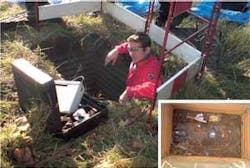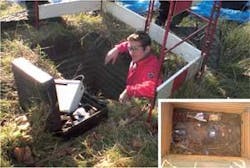Ultrasonic Flowmeters ‘on Top of’ Difficult Water Jobs
By Andrew Sutton
Obtaining useful data isn’t always easy, but some water industry applications are harder than others.
Imagine the scenario: You have to measure the flow of liquid through a pipeline, the pipe is over a metre in diameter, you can only get access to the top of it and the only available access is via a narrow pit in the ground. This is exactly the situation encountered by engineers from Katronic Technologies and its customers on a regular basis. Ironically, a solution is simpler than it might seem.
Unfortunately, for water companies, this difficult situation isn’t only becoming more common, overcoming it is often essential to efficient operation of their network. In an effort to reduce leakage and monitor water distribution, it’s important to be able to determine flow at a variety of points across a network. The drawback is that, to do this, pipes often aren’t exposed – or access is via small chambers in frequently inconvenient places where only the top of the pipeline is accessible.
Trials of different metering systems have proven one of the best ways to measure the application is to mount clamp-on ultrasonic transducers on top of the pipe and use either a portable or installed transmitter unit to display the flow readings. The problem is that anyone ever involved with ultrasonic flowmeters would agree the application described is far from ideal.
Katronic Technologies, though, is proving its instruments are up to this most difficult of jobs. Even with this installation and these sizes of pipes, its KATflow ultrasonic meters are able to provide reliable readings customers need. At one location, the probes were even installed directly on the pipe’s 10-mm bitumen coating and still provided results in line with what the customer was expecting.
The information provided by such equipment is vital to customers as, in many cases, the clamp-on ultrasonic flowmeters provide the only way for engineers to detect possible leakage in these large pipes and to identify the exact location. Other flowmeters are available for conduits of this size, but they all involve pipe modification as well as the cost and time associated with this.
Even insertion electromagnetic flowmeters have limitations for these applications. The length of the flow probes needed for these commonly used instruments can mean that it’s impossible to close the chamber during flow measurement, which creates security and safety issues. Furthermore, detritus carried within flowing water can bend the probes, damaging or causing them to become stuck and thus rendering the metering system useless.
Once a possible metering location is identified a portable KF220 ultrasonic flowmeter can be used to evaluate the application – prior to installing another KATflow meter on a permanent basis. Another advantage of these meters is the range of installation options: All of the sensors can be provided with mounting shoes for either magnetic or weld mounting and, as the sensors are available as IP68 and can be supplied with solid coupling pads, water ingress isn’t an issue.
Moreover, the compact size of some ultrasonic probes means there’s little difficulty in getting the system installed in even the most confined spaces.
Author’s Note:Andrew Sutton is sales & marketing manager at Katronic Technologies Ltd., of Leamington Spa, UK. Contact: +44 (0) 1926 882954 or www.katronic.co.uk
